
Written by
Kelsea Samson is a writer, content manager, certified yoga instructor and founder of The Mindfulness Program for Kids and Yoga for the Blind in Tampa, Florida.
Medical review by
Dr. Michael Galoyan specializes in podiatry and received his doctorate in podiatry from the New York College of Podiatric Medicine. Dr. Galoyan advanced his training by completing a residency in podiatric medicine and surgery at Northwell Health, Long Island Jewish Forest Hills.
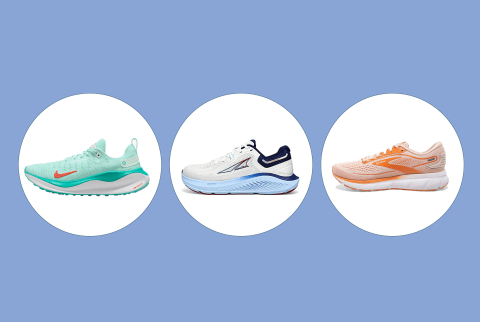
August 19, 2023
Our editors have independently chosen the products listed on this page. If you purchase something mentioned in this article, we may
Whether you’re a seasoned marathoner, casual jogger, or just starting your fitness journey, the right pair of running shoes is essential for your comfort, performance, and preventing injuries1. The best running shoes for women will lessen your chance of muscle damage2 and can actually increase foot strength3.
Studies4 show one in five people (mostly women) experience foot pain, aching, or stiffness regularly. Board certified podiatrist Anne Sharkey, based in Austin, TX, explains, “Choosing the right model based on your foot type is most important. I see [my patients’] foot pain improve as they are fitted with running shoes appropriate for their foot type.”
Since foot types vary, there won’t be a universal best running shoe for everyone. Per podiatrists, there are a few key factors to consider to determine the right pick for you.
What’s the difference between shoes for running, walking, and other workouts?
Shoes designed for activities such as running, walking, or strength training are tailored to the specific demands of each activity.
For example, running shoes are designed for forward motion, while cross trainers support multi-lateral movement. Running shoes will also have more tread than walking shoes. This is because running shoes are engineered to provide the appropriate level of support, cushioning, flexibility, and stability that correspond to the biomechanics and impact forces of each movement.
Sarah Sponaugle, chiropractor and co-founder of Driven Fit, put it plainly: “The difference in running, walking and training shoes is the support design. For running and walking, most of the support is for probation and supination of the foot whereas a good training shoe has all around support to give protection to the ankle for all planes of movement.”
Hillary Brenner, a top podiatrist with practices in NYC and NJ and founder of Dr. Brenner’s RX says, “Running shoes have a greater heel stack height (a more built-up heel) than walking shoes. Walking shoes are less flexible and heavier than running shoes because they’re made for comfort rather than performance.”
“Running shoes also have different levels of heel to toe drop and have better motion control to help with overpronation,” Brenner adds. “The sole of a workout shoe is flatter, making it more flexible to allow a wide range of motion.”
What to look for in running shoes for women
Key priorities when running shoe shopping won’t be style and colorways. Rather, your individual foot type is the most important aspect to consider. To find out your foot shape, Sharkey shared a fool-proof hack:
- Trace your foot with a pencil on a piece of paper.
- Set any running shoe you are considering wearing on top of the paper.
- Your foot should fit within the outline of the shoe. If you foot overlaps the shoe, this shoe is not a good shoe for your foot shape.
Beyond the exercise, podiatrists say the below features are important to look for in the best running shoes for women.
- A thick arch: it’s important to look for running shoes with a thick arch. Per Brenner, a thick arch can boost shock absorption which in turn can take stress off the foot.
- A wide, chunky heel: According to Brenner, a wide, chunky heel can help with motion control and helping with overpronation which can also reduce strain on the foot.
- A snug but not squeezing fit: Per Sharkey, running shoes should be sized on the longer of either arch length or heel to longest toe. You can measure your arch length easily on a Brannock device at your local shoe store.
Our picks of the best running shoes for women:
Best zero-drop running shoe: Altra Paradigm 7
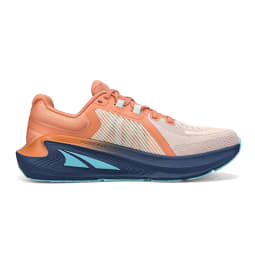
Pros:
- Generous cushion
- Stylish design
- APMA Seal of Acceptance
Cons:
- Not all colors available in wide
- Minimal color options
Sizes available:
5.5-12Half sizes availableSome wide sizes available
Altra is one of Sharkey’s most recommended running shoe brands, and the Paradigm 7 offers the supportive heel counter that she looks for. It’s breathable, responsive, and designed for road running, making it one of Altra’s most popular models.
We even highlighted this shoe in our best zero drop running shoes round up, where it was the top choice of podiatrists. We specifically love its 30mm stack of lightweight midsole foam, which is more cushioned than most other zero drop shoe options without compromising a true zero-drop, barefoot feel.
Plus, The Paradigms offer Altra’s gentle GuideRail technology to encourage a neutral foot placement with each step
Best for road running: Nike React Infinity Run 4
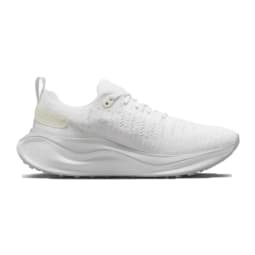
Pros:
- Breathable material
- Good balance of flexibility and support
- More sustainable than previous models
Cons:
- Expensive
- Some reviewers say they run small
Materials:
Semi-recycled materials
Sizes available:
5-12Half sizes available
If you like to take your runs to the road, the Nike React Infinity Run 4 has a lot going for it. It’s even a personal favorite of fitness trainer Julie Stern, Founder of Show Up. “The distribution of the cushion helps prevent heel striking,” she says.
Crafted with the innovative Nike ReactX foam, this shoe promises an impressive 13% surge in energy return compared to its predecessor, the Nike React foam, ensuring a revitalizing and energetic experience.
What’s even more noteworthy is that Nike ReactX not only elevates your performance but also contributes to environmental sustainability, reducing the midsole’s carbon footprint by a remarkable 43% compared to Nike React foam, aligning with your commitment to supporting the planet.
Advertisement
This ad is displayed using third party content and we do not control its accessibility features.
Best for long runs: ASICS Gel Nimbus 24
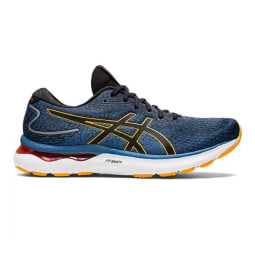
Pros:
- Flexible and well-cushioned
- Lots of color options
- Great for distance running and walking
Cons:
- Not great for wide feet
Materials:
Engineered meshBio-based celluloseNanofiber
Sizes available:
5-13Half sizes available
We called this luxuriously cushioned running shoe out in our 10 best shoes for arch support article, and think it makes the perfect pair for long runs, too. Gohil of DG Podiatrist also touts her love for the brand ASICS and highly recommends them for their “structure, material, and design to help benefit runners.”
Our marathon-running commerce editor loves the Asics Gel Nimbus 24 so much, she wrote a whole article on them. She says, “Like most sneaker brands, ASICS upgrades and evolves its designs over the years. Despite every modification and change, the Gel Nimbus continues to hold up—and I’m constantly impressed. They’re designed for long or short runs (or even walking), so they can be worn for sprints, distance runs, and everything in between.”
Plus, we love that at least 30% of the upper is made from recycled materials.
Best for wide feet: Altra Torin 7
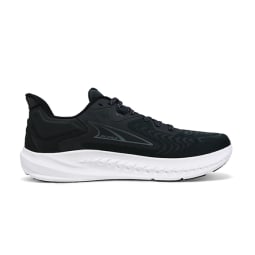
Pros:
- Regular and wide available
- APMA certified
- Podiatrist recommended
Cons:
- Zero drop not for everyone
Materials:
Engineered meshFootPod™ outsole
Sizes available:
7-15Half sizes available
Another Altra shoe on our list? You read that right. Altra is a top running shoe brand recommended by DG Podiatrist and Anne Sharkey, plus the Torin 7 even earned the APMA Seal of Acceptance.
This shoe boasts an additional two millimeters of premium, lightweight foam, enhancing the midsole’s rebound effect. The tongue has been reimagined to provide a more opulent sensation, while a contoured heel collar guarantees a secure and cozy fit.
This running shoe is loved for its innovation and Footshape™, which carefully considers the unique anatomical variations in individuals’ feet. Next, the two extra millimeters of light and luxurious Altra EGO™ MAX foam to the midsole add a little extra bounce and cushion.
Advertisement
This ad is displayed using third party content and we do not control its accessibility features.
Best minimalist running shoe: Peluva Strand
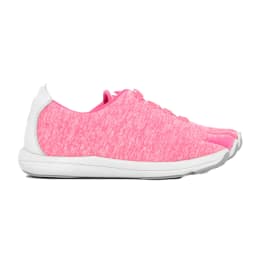
Pros:
- Very lightweight
- Mimics feeling of barefoot running
- Moisture-wicking and breathable
Cons:
- Only 4 color options
Materials:
Polyester insoleRubber outsoleMoisture-wicking mesh
Podiatrists agree that you should always pick an exercise shoe based specifically on the exercise you’re doing, however the Peluva Strand might be a rare acception.
Why, you ask? Because they mimic wearing no shoes at all, which can be beneficial for walking, hiking, running, or hitting the gym if you’re following the barefoot movement. In fact, research shows it can improve foot strength by 57%!
Plus, its durable EVA midsole at a 9mm stack height give it just enough cushion for comfort on hard surfaces while its rubber treads at specific anatomical points to maintain traction on any surface.
Best for high arches: Brooks Ghost 15
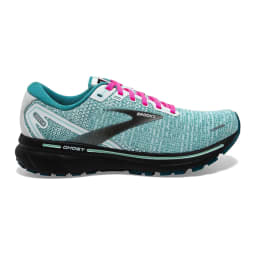
Pros:
- 4 width options
- Contours to your foot
- APMA certified
Materials:
Semi-recycled materials
Sizes available:
5-13Half sizes availableWide sizes available
If you have high arches, don’t sleep on the Brooks Ghost 15. This waterproof, carbon neutral shoe isn’t just the personal favorite running shoe of chiropractor and fitness trainer Sarah Sponaugle. It’s the winner of Runner’s World 2023 Shoe Awards for “best trainer”.
The cherry on top? It earned the APMA Seal of Acceptance for its improved cushioning, smooth transitions, and enhanced upper which promotes foot health. It’s available in medium (1B), wide (2E), extra wide (4E), and narrow (2A) sizes, so everyone can find the right fit.
Sponaugle gave a big thumbs up for recommending her go-to running shoe for women with high arches. “One of the best running shoes for women for an easy, long distance run is the Brooks Ghost.”
Its segmented crash pads deliver support in all the right places and cushioning all around the foot. Then, its 3D Fit Print upper and DNA BioMoGo actually conform to your foot for a Cinderella-fit and superb stability.
Advertisement
This ad is displayed using third party content and we do not control its accessibility features.
Best for stability: Saucony Triumph
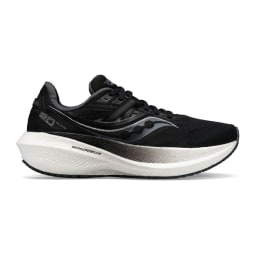
Pros:
- Smooth, rocker feel
- APMA Certified
Cons:
- Some reviews say sizing might be off
Materials:
VeganRecycled materials
Sizes available:
5-12Half sizes available
Return policy:
Free exchangesFull refund within 30 days
Whether you’re running marathons, on the tread, or around your neighborhood, Saucony’s sustainable and well-cushioned sneaker delivers on great stability—an important factor when running shoe shopping. After determining this sneaker to being beneficial to foot health, The American Podiatric Medical Association gave their stamp of approval.
This shoe ticks a lot of niche boxes, like being vegan, semi-recycled, wide sizes available, and over 10 colorways to choose from. Lightweight yet supportive, reviews mention that these shoes are helpful for reducing shin splints, too, since it’s made with extra cushioning for softer landings.
Best for trail running: Hoka SpeedGoat 5
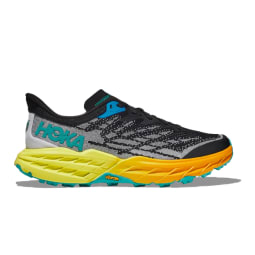
Pros:
- Less weight, more traction
- Ideal for trail runs, golfing, and more
- APMA approved
Cons:
- Less cushioning than the Speedgoat 4
Materials:
Vegan recycled materialsRubber soleEVA foam midsole
Sizes available:
5-12Half sizes available
Every podiatrist we’ve consulted has great things to say about Hoka (all their shoes are APMA certified after all), but Dina Gohil, Founder and CEO of DG Podiatrist (luxury podiatry as seen on Vogue and Cosmopolitan), says these Hoka shoes are specifically great for running on trails. “I’ve always said it’s not a brand but the shoes within a brand that can be the winning combination for people. Hokas are fantastic.”
Sharkey explains, “Because it’s a maximalist shoe, meaning it has a high heal stack, and has foam made of EVA, it helps with shock absorption”, which is perfect for long distance running on trails. These shoes have more room in the toe box for even more comfort, which is why we selected them for the best running sneakers for wide feet and best trail running shoes, too.
The difference between the Speed Goat 4 and 5? Less weight and more traction. (A half ounce lighter, to be exact.)
Advertisement
This ad is displayed using third party content and we do not control its accessibility features.
Best running shoes for beginners: Brooks Trace 2
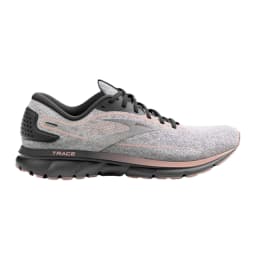
Pros:
- Durable heel
- Ideal for road runs
Cons:
- Tight fit around the toes
- Not APMA certified
Materials:
Recycled materials
Sizes available:
7-15Half sizes available
Return policy:
Free 90 day returns
Brooks is another fan favorites of our podiatrists, though only certain models from Brooks meet APMA standards. The Trace 2 might not be on that list, but it was given the thumbs up in our podiatrist-approved article on best cushioned running shoes.
When you’re just starting out running, a highly comfortable shoe will ensure a more pleasant experience than not. The Trace 2’s breathable materials provide a snug fit without sacrificing airflow, which means more comfortable feet. Then, Brooks’ premium cushioning technology in the shoe adapts to your individual running speed and stride which aims to increase your performance.
If you prioritize a sustainable shoe, you’ll love that this one is made from 45.3 % recycled materials in the upper and 6.54 % made from plastic bottles diverted from landfills.
How we picked:
Podiatrist recommendations
We interviewed podiatrists and chiropractors on their insights to discover the best running shoes for women.
Sustainability
We prioritized running shoes made using sustainable materials and by companies that champion the environment.
Reviews
Each shoe on this list has a fan club of customers who have tried and loved these running shoes, so great reviews influenced most of the options on our list.
Price
We picked running shoes at a variety of price points that won’t skimp on quality, though the best technology is generally an investment.
How should running shoes fit?
According to Dr. Sharkey, running shoes should fit your unique foot shape, your foot size, and should be comfortable immediately and not require a “break in” period. To determine your foot shape, Dr. Sharkey advises to simply “trace your foot on a piece of paper, set any shoe you are considering on top of the paper. Your foot should fit within the outline of the shoe. If your foot overlaps the shoe, this shoe is not a good shoe for your foot shape.”
Next, have your foot measured. You can do this at your local shoe store. “Shoes should be sized on the longer of either arch length or heel to longest toe,” advises Sharkey. Dr. Sponaugle adds, “General running shoes should allow for a thumbnail of space from tip of tow to end of show. This allows for feet to swell slightly and still have room for the feet to activate.”
What is the difference between shoes for weightlifting and shoes for cardio?
The primary distinction between shoes designed for weightlifting and those for cardio lies in their design. Weightlifting shoes are built for stability, support, and a sturdy foundation to facilitate heavy lifts, whereas cardio shoes prioritize cushioning, flexibility, and adaptability to accommodate the diverse movements associated with cardio routines. It’s crucial to select the appropriate shoe type based on your specific activities to ensure optimal performance, comfort, and safety.
Sharkey explains, “Running shoes are more flexible and are going to have a deeper tread and outsole more specific for traction.”
According to our experts, the best approach to prevent injuries and optimize your performance involves owning a dedicated pair of shoes for each activity. Stern elaborates, stating that while running shoes excel during runs, they are unsuitable for weightlifting sessions.
Similarly, Stern advises against using weightlifting shoes for running. “If you can only invest in one pair of shoes, I recommend opting for running shoes with a moderate level of cushioning,” she says. “These shoes can be utilized for both running and cross-training. During weightlifting workouts, it’s possible to go barefoot, as long as you take safety precautions.”
How running impacts health and longevity
Running can have a significant impact on health and longevity5, as it offers a range of physical, mental, and well-being benefits.
Gohil explains, “Of course there are pros and cons to running. Let’s start with the positives: It’s an excellent way to improve cardiovascular health and strengthen muscles. It can help improve quality of sleep, mental health6, and even help reduce weight. Cons include the natural wear and tear of joints, shin splints, blisters, knee and back pain.”
According to Sharkey, “Exercise improves mental health. Exercise also improves cardiovascular health. Anything that positively impacts our health will ultimately impact the longevity and quality of life we experience.” To us, that sounds like the perfect reason to upgrade your collection of workout shoes.
Brenner concludes, “Exercise helps with circulation ie helping prevent chronic diseases such as diabetes and heart disease, helps strengthen bones plus increase positivity for the mood. Strenuous exercise can be damaging to the heart but regular to moderate activity such as brisk walking have been associated with increasing life expectancy by several years.”
FAQ:
Are Hokas good for long distance running?
According to our experts, yes because it’s a maximalist shoe and made of EVA which is a foam that helps with shock absorption.
Is it OK to wear running shoes for walking?
Our experts agree that some running shoes can double as walking shoes, but it’s always best to have a shoe designed specifically for each activity.
Is too much cushioning bad for running shoes?
Our experts say it depends on the individual. Some runners benefit from the extra cushioning and require more shock absorption for their joints.
How often do you need to change your running shoes?
Every 6 months or 300 miles.
Do running shoes help with foot pain?
According to our experts, they can as they are built taking shock absorption into mind which in turn can take stress off the foot. Running shoes are made for motion control which also helps with relieving strain from overpronation.
The takeaway
Remember, investing in quality running shoes is also an investment in your running performance, comfort, and overall health—but you shouldn’t wear running shoes for weightlifting. For those podiatrist-approved recommendations, check out our roundup of the best weight lifting shoes of 2023.
